
In Petrushka Stravinsky uses folk songs and popular tunes as an important part of his musical material. This section contains 4 songs and 2 short instrumental pieces in sheet music form (pdf files) and sound samples. The words are ours, not Stravinsky's.
• Ding dong ding
• Sad tune
• Moor’s tune
• Oh I have a little table in the middle of my room
• Petrushka you’ve got a jinx on you
Singing in class is nowadays too often neglected. Children sing with gusto if they like the songs and should be encouraged to do so.
We have added new texts to some of the songs to make them more fun.
The numbers that appear in the text eg 106 are rehearsal figures from the orchestral score of the 1947 version of Petrushka and will take you directly to an excerpt of Stravinsky’s music.
Ding dong ding Download sheet music.
Download sheet music.
Listen to the song.
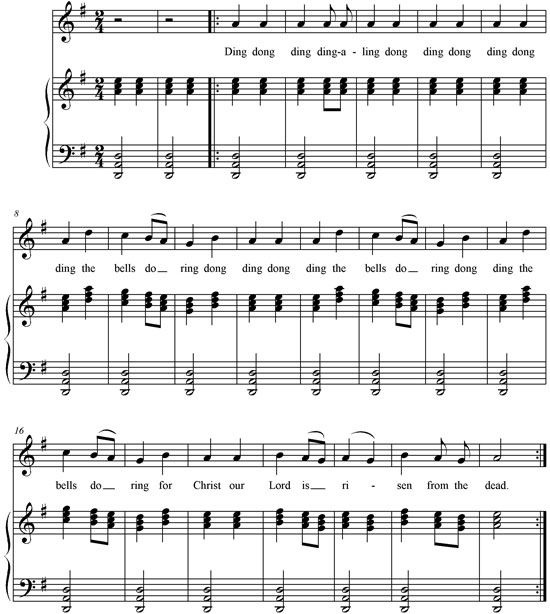 1. Teach the song to the children.
1. Teach the song to the children.To help them keep pitch you might ask one of the children to play the notes D and A (with the D in the bass) on a large xylophone or metallophone, in the bass register on the piano, or, if you are lucky enough to have a child who already learns an instrument, for example on a violin or cello.
Ask the instrumentalist(s) to repeat the note(s) in a pulse that fits with the tune.
NOTE The children can also learn the song by listening to it. Play the song to them until they know it and sing along with it.
2. If the children enjoy singing, print out the music and teach some of them the lower part so that they can sing it in two parts.
3. Accompany the tune with triads.
Demonstrate a triad to the children. It is a chord consisting of 3 notes, each a third apart:
- go to a piano (or take a xylophone);
- play any note;
- miss the next note (going up or down; it doesn’t matter) and play the next;
- going in the same direction, do the same again (miss a note and play the next one).
The 3 notes you have played form a triad. Now invite a child to find a triad and play it to the class. Then another, until everyone understands what a triad is and how to play it.
Try playing all 3 notes simultaneously (you will need 3 beaters, or 3 children, if you are using a xylophone). Most triads sound friendly on the ear.
The printable music is accompanied with triads that move parallel to the tune.
4. The accompaniment could be played by three children on a xylophone, but they will need to practice it first. Or it could be played by a child who plays the piano. The pianist simply locks his or her fingers in the triad position and follows the top part.
5. You may wish to arrange this part for any instrumentalists you have in school.
The music is supported in the bass by a drone of repeated Ds and As.
How Stravinsky does it
Sad tune Download sheet music.
Download sheet music.
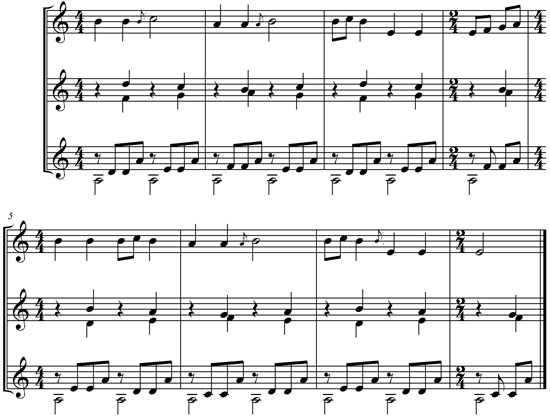
Sad tune is the moment in the ballet when Petrushka thinks jealously of the Moor. 104
The little notes (they are called grace notes) are tiny sobs within the tune. They are played or sung quickly, squeezed in before the next note of the tune to make it sound more emotional. Explain to the children that the Italian musical name for this kind of grace note is acciaccatura (pronounced a-chia-ka-too-ra) from the Italian word meaning to crush.
1. Help the children to learn to play the tune. They might like to invent some sulky words and sing it too. The accompaniment is very simple. The bass note is a repeated E (a pedal note or drone). The middle part moves up and down in steps.
2. The tune is incomplete. Invite the children to invent an ending for it.
How Stravinsky does it
Moor’s tune Download sheet music version 1 (simplified).
Download sheet music version 1 (simplified).
 Download sheet music version 2 (full harmony).
Download sheet music version 2 (full harmony).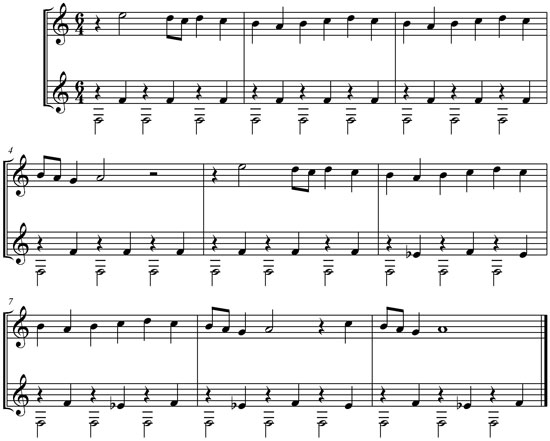
This tune sums up one element of the Moor’s character. He is vain and idle.
1. Listen to the Moor’s tune in Petrushka 125
. Then print a copy and help some of the children to perform it. The tune should be as smooth as possible and the ostinati should be short and brittle.
You will need to replace F with F# on xylophones and other tuned instruments.
2. Perhaps the children would like to add untuned percussion instruments to the accompaniment to make it sound more exotic and oriental.
3. In Stravinsky’s version the Moor demonstrates that he is also powerful and frightening by sudden aggressive outbursts.
Ask the children, working in groups, to invent their own aggressive outbursts that might come between repetitions of the tune. Explain that these outbursts must not simply be banging around on instruments! When Stravinsky composed his outbursts, he thought about them carefully and decided precisely what each musician should play and exactly when. Ask the children to do the same. Their outbursts should sound the same every time they perform them, so every member of the group must know exactly what he or she is going to play and when to play it.
4. When the outbursts are ready ask each group to perform to the class and discuss with the children how accurate and effective they are. If the class decides that a particular group needs to improve its music, give it some time to do so.
5. When all the music is ready ask the children to perform their outbursts between repetitions of the Moor’s tune:
Moor’s tune ; outburst 1 ; Moor’s tune ; outburst 2 ; Moor’s tune etc.
- Should the Moor’s tune come between each group’s outburst or is there a better way of organising the piece?
- Would it work if two of the outburst groups performed simultaneously?
- Should the Moor’s tune be the same every time?
How Stravinsky does it
Oh I have a little table in the middle of my room Download sheet music.
Download sheet music.
Listen to the song.
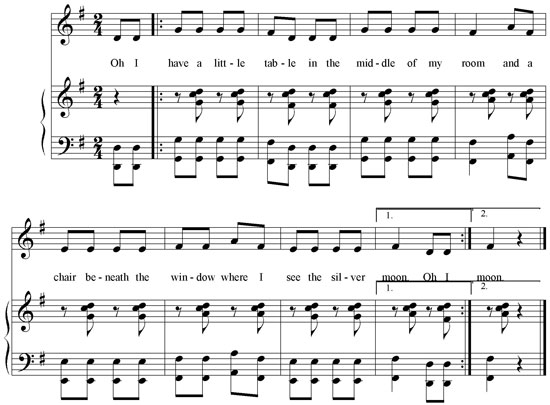
Sing the song with the children, starting on the note D. It is extraordinarily short and takes under 10 seconds to sing! This song will also work as a round.
Now add an instrumental accompaniment. You will need to substitute F# for F on xylophones etc.
1. Divide into groups and ask each group to choose either D or A as a drone (like the continuous note of a bagpipe) to accompany the song.
2. Now invite someone in each group to add a simple ostinato using only the notes B, C and D (but not necessarily in that order). This will fit nicely with the piano accompaniment if you decide to use it.
3. When the first ostinato is established, ask a child to add another. Perhaps this one should be a little more elaborate, with gaps in it so that it everything doesn’t go on all the time.
4. Explain to the children that ostinati can be rhythms too. Can the remaining members of the groups add ostinati using small untuned percussion instruments?
How Stravinsky does it
Petrushka you’ve got a jinx on you Download sheet music.
Download sheet music.
Listen to the song.
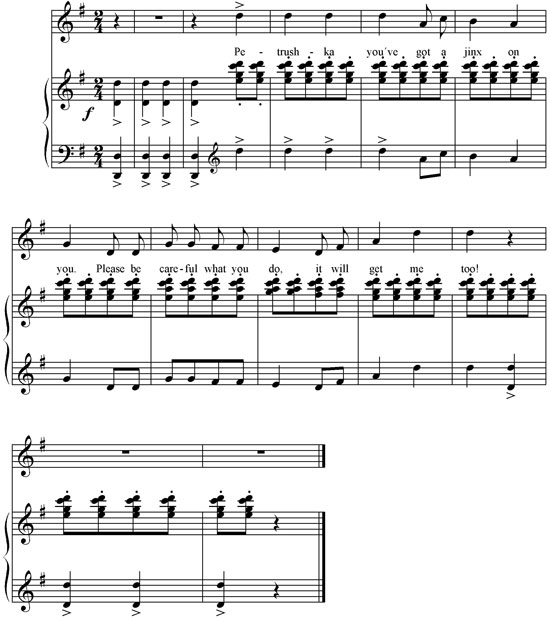
Listen to the workshop performance
.
Teach the song to the children and sing it through several times as a class. You might prefer the children to learn it by listening to Irina singing it
until they know it and can join in.
The song starts on D, which is quite high. The children may need to be encouraged to stand up, lift up their heads, and go for it!
You may wish to use piano accompaniment.
1. Invite the children to accompany their singing with a rhythmical beat. They may wish to clap their hands or stamp their feet. Introduce the idea of ostinato by encouraging them to invent a rhythmic pattern that repeats continuously throughout the song.
2. Ask someone to play (or sing) the drone note D. Should it be a continuous note or should it too have a rhythm? If you have a child in the class who is learning the violin, you might ask him/her to play the drone. Violins can play drones very effectively and D is an open string.
3. We all know that Frère Jacques is a round or canon.Try Petrushka you’ve got a jinx on you as a two-part round. The second group starts when the first group gets to "got". The round will work in four parts, successive groups starting when the first group reaches the words "got", "please" and "it'll".
4. If the song is performed round and round continuously the listeners will soon become bored. Divide into groups and ask each group to invent a little instrumental interlude using a different drone and ostinati, perhaps using fragments borrowed from the song. The interludes can be used to break up the singing of the song:
SONG ; interlude group 1; SONG ; interlude group 2; etc.
Now listen to a short excerpt of Stravinsky’s version. 229
How Stravinsky does it

